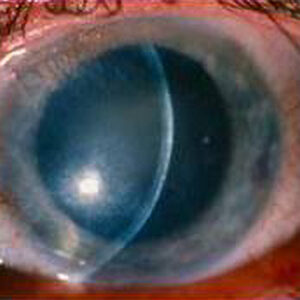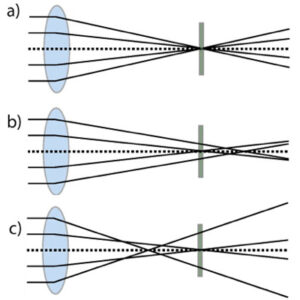Practice Management
April 2007
by Riva Lee Asbell
A little quiz: Two case scenarios
Here are two case scenarios—pick the one you think fits the definition of complex cataract surgery:
Case 1. Pre-op and Post-op Diagnoses:
Visually significant cataract, right eye; Expulsive hemorrhage, right eye.
Operation: 1. Extracapsular cataract extraction with phacoemulsification, right eye; 2. Anterior vitrectomy, right eye; 3. Peripheral iridectomy, right eye; 4. Closure of incision with subsequent management of expulsive hemorrhage.
Note: Case was performed by a resident in an academic medical center. No teaching physician presence was noted.
Case 2. Pre-op and Post-op Diagnoses:
Cataract, left eye with zonular dehiscence.
Operation: Cataract extraction by phacoemulsification and IOL implantation, left eye with insertion of a capsular tension ring.
Complications: Peaking of the pupil was noted with no vitreous loss; inability to later visualize inserted capsular tension ring during procedure.
Keeping in mind that the term is complex, not complicated, cataract extraction, Case 2 qualifies for using the code for complex cataract extraction (CPT code 66982) whereas Case 1 cannot even be billed since there was no attending present. (If an attending was present or the case was done privately the correct coding would be 66850-52).
Definition of complex cataract
CPT code 66982 is defined as follows: “66982 Extracapsular cataract extraction removal with insertion of intraocular lens prosthesis (one stage procedure), manual or mechanical technique (e.g., irrigation and aspiration or phacoemulsification), complex, requiring devices or techniques not generally used in routine cataract surgery (e.g., iris expansion device, suture support for intraocular lens, or primary posterior capsulorrhexis) or performed on patients in the amblyogenic developmental stage.” Originally, the words “endocapsular rings” were included but this was subsequently withdrawn due to lack of Food and Drug Administration (FDA) approval at the time and never reinserted in the description even after FDA approval was obtained. However, when one of these devices that is FDA approved is used, I believe it is proper to use the complex code.
The rationale provided in CPT Insider in 2001, the year the code was introduced into CPT was as follows: “66982 has been added to delineate procedural differences associated with the removal of extracapsular cataract(s) and lens insertion performed in the pediatric age group, on patients who present with diseased states, prior intraocular surgery, or with dense, hard and/or white cataracts. The presence of trauma, or weak or abnormal lens support structures caused by numerous conditions (e.g., uveitis) and disease states (e.g., glaucoma, pseudoexfoliation syndrome, Marfan’s syndrome) require additional surgical involvement, and utilization of additional techniques and surgical devices. A small pupil found in a patient with glaucoma or a past surgical history may not dilate fully, and will require iris retractors through additional incisions. Capsular support rings to allow the placement of an intraocular lens may be required in the presence of weak or absent support structures.
Pediatric anatomy contributes to the complexity of cataract surgery. The anterior capsule tears with great difficulty and the cortex is difficult to remove from the eye because of intrinsic adhesion of the lens material. Additionally, a primary posterior capsulotomy or capsulorrhexis is necessary, which further complicates the insertion of the intraocular lens.”
Documentation requirements Documentation of the characteristics that qualify the case as complex should be noted in the outpatient chart as well as the operative notes. Under audit, frequently only the hospital or ASC is contacted, and if the documentation is not presented in a preliminary paragraph or similar notation, then the case will not be considered as complex.
What qualifies as complex?
Surgical complications. Complications encountered during surgery simply do not qualify the case to be coded as CPT code 66982—among these would be iris prolapse, vitreous loss, choroidal hemorrhages, and dropped nuclei.
Floppy iris syndrome. The identification of this entity occurred after the complex code was developed. The inherent difficulties found during cataract surgery on many patients undergoing or who have undergone treatment with Flomax, usually qualifies the case as being considered complex.
Presbyopia-correcting or toric intraocular lenses. The use of a presbyopia-correcting or toric intraocular lenses in general, including Crystalens (eyeonics, Aliso Viejo, Calif.) specifically, do not qualify as making the case complex.
Torsional phacoemulsification. Use of this technique does not qualify the case to be considered complex.
Fugo blade. Use of this instrument does not qualify the case to be considered complex.
Common questions regarding CPT CODE 66982
Question: Can this code be used when dense cataracts are removed in conjunction with application of indocyanine green (ICG) or trypan blue?
Answer: Yes, the use of ICG with dense cataract removal does qualify. Caveat: If this is performed routinely, such as when teaching residents, then it does not qualify.
Question: What types of pupillary enlargement procedures would qualify for using this code?
Answer: This depends on your local Medicare carrier’s Local Coverage Determination (LCD) and Coding Guideline, if there is one. The various authorities at the ophthalmology societies believe that both the use of iris retractors and pupillary stretching should enable the use of 66982. However, there are local Medicare carrier policies that do not include manual pupil stretching as qualifying.
Question: Can synechiolysis be billed in addition to code 66982?
Answer: No. As stated above, the definition of 66982 includes “requiring devices or techniques not generally used in routine cataract surgery.” The intent of the code is to include any form of synechiolysis. Both codes 66984 and 66982 were bundled with the various synechiolysis codes in Version 7.2 of the National Correct Coding Initiative effective July 1, 2001.
Question: Can a vitrectomy be billed in addition to the procedure code?
Answer: It depends. If CPT code 67005, removal of vitreous, anterior approach (open sky technique or limbal incision); partial removal, or 67010, subtotal removal with mechanical vitrectomy, is used, ordinarily they are bundled by the National Correct Coding Initiative. However, in pediatric cataract surgery, when a limited pars plana vitrectomy is performed, that may be billed additionally. It is recommended that modifier–52 be applied when this is a limited pars plana posterior vitrectomy.
Question: Can code 66982 be used in pediatric cases when an IOL is not inserted?
Answer: No. An IOL must be inserted to use this code even though pediatric cataract extraction may be more difficult that adult cataract extraction.
Editors’ note
CPT codes copyright American Medical Association 2007
About the author

Riva Lee Asbell, an ophthalmic reimbursement consultant, is the principal of Riva Lee Asbell Associates in Philadelphia and Fort Lauderdale. Contact her at www.RivaLeeAsbell.com.



